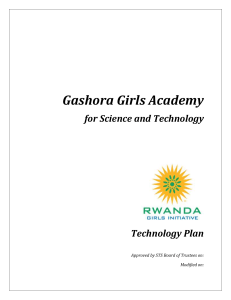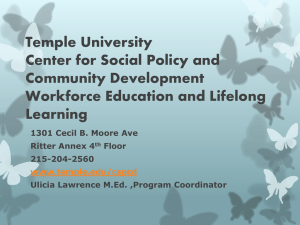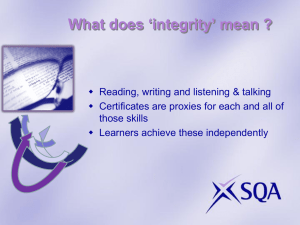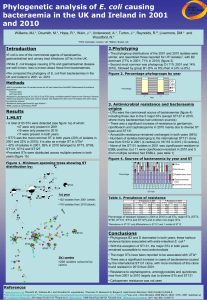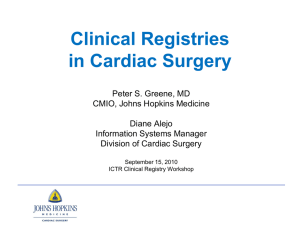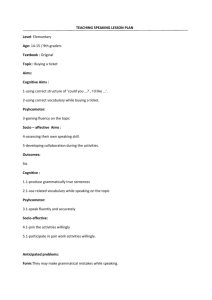Effective strategies for developing academic English
advertisement
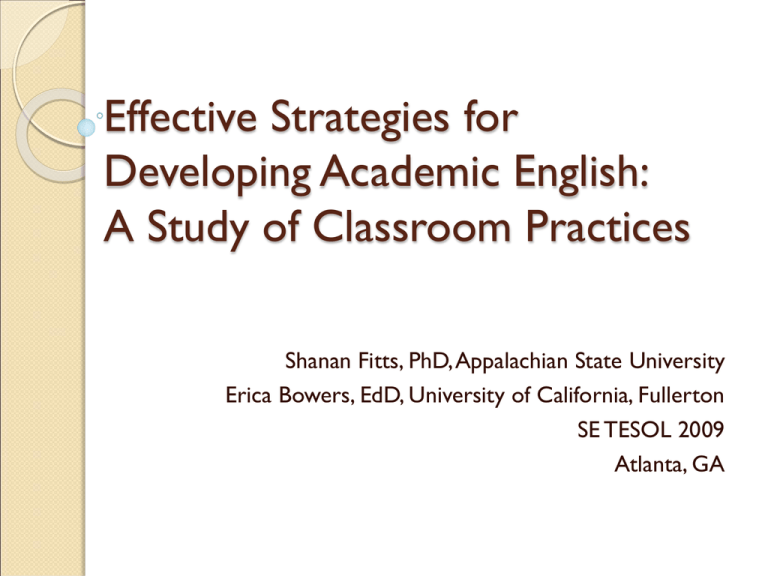
Effective Strategies for Developing Academic English: A Study of Classroom Practices Shanan Fitts, PhD, Appalachian State University Erica Bowers, EdD, University of California, Fullerton SE TESOL 2009 Atlanta, GA Rationale for Study Increased testing mandates for ELLs English learners struggle with text-level comprehension (August & Shanahan, 2006) Long-term English learners (Freeman & Freeman, 2009) Teachers of English language learners report feeling illprepared (Coley & Coleman, 2004). Increased focus on the concept of academic English in PD and instructional programs Teaching advanced literacy is complicated (Fillmore & Snow, 2000) 2 Purpose of Study Observe upper elementary teachers to see what strategies they used to build their students’ proficiency in academic English Observe of ELLs classes with high percentages Research Questions What kinds of classroom teaching practices are upper elementary teachers using to help students develop advanced proficiency with comprehending and using academic English? ◦ Which kinds of strategies do teachers report to be effective? ◦ Are these reported strategies observed in the classroom? ◦ Which strategies appeared to be effectively implemented? ◦ Of those strategies observed, which needed further practice, explanation, or development? Academic Literacy Students must be able to develop: Vocabulary Syntax Discourse genres & Registers Identities (Bailey, 2007; Gee, 1996; Gottlieb, 2006) Large urban school district in Southern CA Classrooms leveled according to student test performance ◦ 4- Excel or Enriched ◦ 1- Literacy ◦ 3- no special designation All had students identified as ELL “Normal” & Literacy classrooms higher % of ELLs at beginning & intermediate levels Teacher Selection Original pool of 108 survey participants 28 teachers consented to participate observations 8 agreed to observations Teacher Selection High Self-Report Low Self-Report on Survey of on Survey of Strategies Used Strategies Used => 3.0/4.0 =<3.0/4.0 High Test Scores (=>65% proficient or advanced on CST in ELA) 1 4 1 2 Lower Test Scores (=<49% proficient or advanced on CST in ELA) Overview of the PD Year 4 of district PD for Language Arts (SB 1066) A Focused Approach (Dutro& Moran, 2003; EL Achieve) ◦ Form & Function ◦ Brick words– topic specific ◦ Mortar words– grammatical forms & general vocabulary ◦ Use of sentence stems ◦ Frontloading (preteaching) ◦ Opportunities for sts to practice language Overview of the Classroom Observations Researcher-developed protocol Two researchers observed each lesson 4-6 lessons observed in each room Four broad areas: ◦ Schema building ◦ Comprehensible input ◦ Explicit Teaching of Concepts and Skills ◦ Providing Opportunities for Practice Overview of the Classroom Observations 0-3 Rating scale ◦ 0 = Not Observed ◦ 1= Shows ineffective implementation; limited understanding of strategies. Done w/out considering sts needs ◦ 2= Partial implementation. Meeting some sts. needs & trying to take some sts. needs/prior knowledge into consideration ◦ 3= Effective implementation of strategy. Meets the needs of the student. A Portrait of an Effective Teacher Higher level of student engagement Higher teacher engagement Differentiation Applying strategies thoughtfully Responding to needs of sts Aware of strengths & weaknesses Look to teaching not blaming sts Findings for each area Effective Schema Building Activate prior knowledge (student’s personal experiences) Link past to prior content learning Use of graphic organizers or semantic webs to assess & elicit prior knowledge Preview or teaching vocabulary T: ….what kind of map is this? SS: Bridge map. T: the line on this bridge map is going to represent “means.” Where have you heard ped or pod before? Hands down, I want to give you time to think. (2 sec) Okay share with your table. SS: i-pod T: not a brand name (T uses selector spinner on overhead to select students from tables to share.) St: pedicure. (T writes on the circle map and asks st what the word means). (Other sts offer words and informal definitions.) T: okay we have lots of words that have ped in them (names words and underlines the ped part of the word). I want you to think on your own—what do all of these words have in common (no wait time for thinking here) talk to your table. St—they all have ped. T: we already know that they all have ped—I want you to think about the meaning of the words. What do all of the meanings have in common? Effective Comprehensive Input Emphasizes distinctive features of new concepts Provides examples and/or non-examples to illustrate new skills/concepts/strategies Breaks down skills /strategies/concepts into smaller/simpler components Provides clear input about the concept or content Clarifies instructions Wait time Leveled questions or tasks Comprehensible Input Teachers emphasize key concepts & vocab ◦ Repetition ◦ Choral response ◦ Visuals Teachers are animated: ◦ Gestures, expression, engaged teaching Teachers chunk & scaffold: ◦ Reading around the room Comprehensible Input http://www.sikhspectrum.com/092002/images/gold_panning.jpg Clarifies Instructions What tools will we be using? (the pick and the shovel) Wrote the different mining techniques that they had discussed on the board Rephrases to clarify: What is the same about those pictures? What is one similarity? Emphasizes distinct features of concepts and provides examples Used hands-on activity to emphasize some of the difficulties encountered in gold mining Used visuals to teach about mining techniques and about gold. Has visuals on the PP and hands out visuals for each method of mining “Are the pictures I just passed out modern or from 1848?—what’s different about this picture?” Used choral repetition to emphasize some key vocab and concepts. For example, “everyone say ore. That’s a noun; it’s not the same as “o-r” “You swirl it around in the water and then what did we say, is gold heavier or lighter than the water?” SS: “Heavier!” Key words and idea are underlined or in italics in the PowerPoint. Explicit Teaching Models processes and skills, strategies, or concepts Strategy Instruction Use of Expository Text Instruct academic language Explicitly teaches vocabulary Writing Leveled Questions to Prepare for a Socratic Seminar Critical Thinking Question Stems How did ____ feel about ____? What was ______ probably like? How is _____ different from ____? Why couldn’t ____ do ________? Why did _______ do ________? Why was ______________? How did ____________? What caused the __________ to ______? What will ____ do next? What probably would have happened if __________? Modeling with the Titanic “I have these stems that are gonna help me. A good idea is to find a fact and go from there. Here’s an interesting fact: The Titanic was thought to be the world’s first unsinkable ship. I’m gonna go with this first stem. How did the passengers feel about being on an unsinkable ship?” (Sts. discuss this question with tables and with the class). “Okay, so first I’m going to find an interesting fact; something that makes me think. Here’s one (T underlines the fact on the overhead)—the fact that only 700 people got on life boats, but the life boats were suppose to be for 1178 people—that makes me think… that makes me confused… so I’m gonna ask: “what caused the boat to carry only 700 people” Opportunities for Practice Students orally elaborate concepts Variety of grouping strategies Students use content language Teachers integrate more than one language skill Writing in content areas Students practice academic language Students are given time to explain their ideas Lesson on colonial America: Ss had opportunities to tell something they learned about life in colonial times during the previous day’s activity. “Scholars, if I didn’t call on you, please turn to your neighbor and tell them what you were going to say.” e.g. S: traveling wasn’t for fun in colonial times. T: what do you mean? S: well they didn’t go on vacations or cruises. T: so when they traveled it was because they had to and not for fun. Good point. Opportunities for Practice Half of the teachers we observed provided very few structured opportunities for students to practice and apply academic language Summary of findings Teachers that rated higher… Teachers that rated lower… Used graphic organizers effectively Used some graphic organizers, but with a lot of teacher talk Used leveled questions & sentence stems Followed scripted curriculum; not Used explicit teaching but also allowed for student construction of always aware of Ss needs, interest, or level of comprehension. knowledge Used a variety of grouping strategies to scaffold student participation Relied mostly on whole class teaching with less structured use of grouping strategies Gave students opportunities to elaborate or clarify ideas and oral output Used I-R-E which allowed for shorter responses from students Limitations of current study Limited number of observations in each teacher’s class All observations conducted at end of the year within one month Unable to collect detailed data on student output Using CST scores to measure efficacy of teacher when classes are leveled Conclusion All teachers were using strategies learned in PD ◦ Some following script ◦ Others incorporating these into their approach and responding to Ss needs Each area reinforces the others Connecting theory to practice: ◦ Some teachers seemed to understand why particular strategies were important and were able to communicate that to students ◦ Variation in teachers’ ability to incorporate and apply strategies Teachers applied GATE training Limitations of scripted curricula What is our definition of effective? ◦ Is effective just a matter of getting the S achievement on standardized tests? References August, D., & Shanahan, T. (Eds.) (2006). Developing literacy in second-language learners: Report of the national literacy panel on language-minority children and youth. Mahwah, NJ: Lawrence Erlbaum. Bailey, A. L. (Ed.). (2007). The language demands of school: Putting academic English to the test. New Haven, CT: Yale University Press. Coley, R. J. & Coleman, A. B. (2004). The fourth-grade reading classroom: Policy information report . Princeton, NJ; Educational Testing Service. (ERIC Document Reproduction Service No. ED 485193) Dutro, S. & Moran, C. (2003) Rethinking English language instruction: An architectural approach. In G. Garcia (Ed.), English language learners: Reaching the highest level of English literacy. Newark: IRA. E. L. Achieve. (n.d.). Focused approach - Overview presentation. Retrieved July 29, 2009, from http://www.elachieve.org/ Freeman, D. E., & Freeman,Y. S. (2009). Academic language for English language learners and struggling readers: How to help students succeed across the content areas. Gee, J. P. (1996). Social linguistics and literacies: Ideology in discourses (2nd ed.). London: Taylor & Francis. Gottlieb, M. (2006). Assessing English Language Learners: Bridges from language proficiency to academic achievement. Thousand Oaks, CA: Corwin Press. Marzano, R. J. (2004). Building background knowledge for academic achievement. Alexandria,VA: Association for Supervision and Curriculum Development. 32




